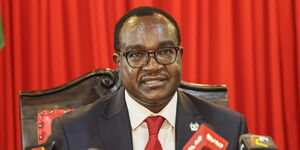Kenya’s shilling displayed remarkable resilience against the US dollar, closing the week on a stable note despite global market turbulence and looming US elections. The currency traded at Ksh129.20 per US dollar on August 15, maintaining its ground compared to Ksh129.41 per US dollar a week earlier.
The Central Bank of Kenya (CBK) affirmed this stability, noting that the shilling remained steady against major international and regional currencies during the week ending August 15.
In a bulletin, CBK highlighted, “The Kenya Shilling remained stable against major international and regional currencies during the week ending August 15. It exchanged at Ksh129.20 per US dollar on August 15, compared to KSh 129.41 per US dollar on August 8.”
However, this stability comes amidst concerns about the country’s dwindling forex reserves. The reserves, which serve as a critical buffer for the economy, fell by approximately Ksh3.08 billion, reaching $7.316 billion, equivalent to 3.8 months of import cover, down from $7.34 billion the previous week.
This drop in forex reserves, though slight, is significant as it brings the reserves closer to the statutory requirement of maintaining at least four months of import cover.
CBK reassured the public that, “The usable foreign exchange reserves remained adequate at USD 7,316 million (3.8 months of import cover) as of August 15. This meets the CBK's statutory requirement to endeavour to maintain at least 4 months of import cover.”
Traders in the forex market had anticipated pressure on the shilling due to increased demand for foreign currency from the manufacturing sector. However, the successful auction of a Ksh50 billion infrastructure bond earlier in the week provided a much-needed cushion.
One trader who spoke to Reuters noted, “There’s a lot of FX demand kicking in. What had lifted the shilling was the infrastructure bond auction. Now the market fundamentals are coming back into play.”
Forex reserves, comprising cash, gold, and other assets held by central banks, play a pivotal role in stabilising a country’s currency and ensuring liquidity during economic crises.
They enable central banks to intervene in the forex market to maintain the value of the domestic currency, support imports and exports, and reassure foreign investors, particularly during periods of political or economic instability.
The shilling’s stability this week aligns with a broader positive trend in global markets. On Friday, global shares saw an upward trend, buoyed by positive U.S. economic data that eased fears of a recession.
This, in turn, tempered expectations of an aggressive interest-rate cut by the Federal Reserve next month, a move that had been anticipated to ease market pressures.
Kenya’s infrastructure bond sale, a key litmus test for investor confidence following recent anti-government protests, attracted significant demand.
During the August auction, the government reopened two infrastructure bonds intended to fund projects in the current fiscal cycle. The response was overwhelming, with the government receiving bids totalling Ksh126.3 billion, more than double the Ksh50 billion initially on offer, marking a 252 per cent oversubscription. Out of these bids, the government accepted Ksh88.7 billion, translating to a 70.2 per cent acceptance rate.
Investor interest was notably skewed towards the shorter-term 6.5-year bond, which saw a 193.7 per cent oversubscription. This preference reflects investors' cautious approach, opting to hedge against duration risk while adopting a wait-and-see strategy with regard to longer-term government securities.
In contrast, the 17-year bond was undersubscribed, attracting bids worth Ksh29.5 billion and recording a 58.9 per cent subscription rate.
This disparity highlights the ongoing market apprehension about committing to longer-term investments in the current economic climate.












